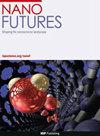Dynamics of light-induced charge transfer between carbon nanotube and CdSe/CdS core/shell nanocrystals
IF 3.3
4区 材料科学
Q3 MATERIALS SCIENCE, MULTIDISCIPLINARY
引用次数: 0
Abstract
The integration of semiconducting colloidal nanocrystals (NCs) with carbon nanotubes (CNTs) in a single device presents a unique platform that combines optical flexibility with high charge carrying capability. These qualities are desirable in many applications such as photovoltaic cells, photocatalysis, and light sensors. Here, we present hybrid devices that incorporate various CdSe/CdS core/shell NCs, such as seeded quantum dots and asymmetric seeded nanorods (a-sNRs), with a single-wall CNT in a field-effect transistor geometry. We used electrical measurements to probe a light-induced charge transfer (LICT) between the CdSe/CdS NCs and the CNT. We investigate the effect of gate voltage on the LICT magnitude and temporal characteristics. Surprisingly, the measured photo-response depends on the gate voltage, and we observe both electrons and holes transfer from the a-sNRs to the CNT. Furthermore, a comparison between LICT measurements on different devices with different CNTs and NC types reveals that the charge transfer time is directly proportional to the shell-thickness around the CdSe core and inversely correlated with the NCs size. The recovery of the charge trapped inside the CdSe/CdS NCs is characterized by two distinct fast and slow relaxation times, which depend on the NCs size and CNT type. Although, the charge relaxation time is similar between the symmetric QDs and the asymmetric sNRs, the overall percentage of the remaining charge in the QDs is significantly larger than in the sNRs. Understanding both gate voltage and NCs size effect on the LICT processes can optimize the performance of optoelectronic devices.碳纳米管与CdSe/CdS核/壳纳米晶体间光诱导电荷转移动力学
半导体胶体纳米晶体(NCs)与碳纳米管(CNTs)在单一器件中的集成提供了一个独特的平台,结合了光学灵活性和高载电荷能力。这些特性在光伏电池、光催化和光传感器等许多应用中都是理想的。在这里,我们提出了混合器件,结合了各种CdSe/CdS核/壳NCs,如种子量子点和非对称种子纳米棒(a- snrs),具有场效应晶体管几何形状的单壁碳纳米管。我们使用电测量来探测CdSe/CdS纳米碳纳米管和碳纳米管之间的光诱导电荷转移(LICT)。我们研究了栅极电压对LICT幅值和时间特性的影响。令人惊讶的是,测量的光响应取决于栅极电压,我们观察到电子和空穴从a- snr转移到碳纳米管。此外,在不同碳纳米管和碳纳米管类型的器件上,电荷转移时间与CdSe核心周围的壳层厚度成正比,与碳纳米管尺寸成反比。捕获在CdSe/CdS纳米管内的电荷的恢复具有两个不同的快弛豫时间和慢弛豫时间,这取决于纳米管的大小和碳纳米管的类型。尽管对称量子点和非对称信噪比的电荷弛豫时间相似,但量子点中剩余电荷的总体百分比明显大于信噪比。了解栅极电压和nc尺寸对LICT工艺的影响可以优化光电器件的性能。
本文章由计算机程序翻译,如有差异,请以英文原文为准。
求助全文
约1分钟内获得全文
求助全文
来源期刊

Nano Futures
Chemistry-General Chemistry
CiteScore
4.30
自引率
0.00%
发文量
35
期刊介绍:
Nano Futures mission is to reflect the diverse and multidisciplinary field of nanoscience and nanotechnology that now brings together researchers from across physics, chemistry, biomedicine, materials science, engineering and industry.
 求助内容:
求助内容: 应助结果提醒方式:
应助结果提醒方式:


